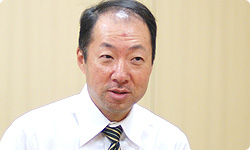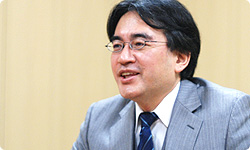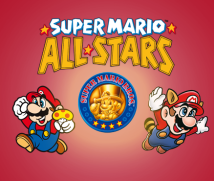4. Music Commentary by Koji Kondo (1)
Kondo-san, now I think I’d like you to offer some commentary on the ten songs included on the Super Mario History Soundtrack CD, otherwise known by us as Koji Kondo’s Greatest Hits.
All right.
And, of course, the two of you can offer your thoughts about the music as well. Shall we start?
I could only generate three sounds at once on the Famicom, but I wanted to make something that would be distinctive, naturally sound like music as much as possible given the restrictions, and be fun precisely because of using only three sounds. I tried to make the music different by location, breaking it down into above ground, underwater, underground, and in the castle.
They do all sound quite different.
This is the Ground Theme for Super Mario. The first thing you see in the game is an expansive blue sky and an open field, so I tried to represent that in the music.
Before Super Mario Bros. came out, most games had a black background.
Right. That blue sky was really refreshing. I wanted music to match that, so I made the mistake of creating something easy-going, like you’re out for a carefree walk.
What happened to that song?
It got canned. I realised that an easy-going sound wouldn’t match Mario’s running speed and the way he jumps. I remade the song so it would match the rhythm of his movements, and that became the Ground Theme.
Did you start over from scratch?
There’s a noise in there like triplets. ♪Tee tee-tee…tee tee-tump… I took that from the first song I made. I was going to remake the whole thing, but when I wrote the new melody and listened to it, I decided to try out that noise, and it just seemed to fit. It had a groove that suggested moving forward, so I kept it just as it was.

Musically, that’s really unusual. It goes ♪tee tee-tee tee… So usually you would have to change the melody to fit it.
If you had composed it normally, the melody would have adopted a swing, too.
Yeah.
It seems like they aren’t a perfect fit, but somehow I think that matches the game. I think it formed a striking characteristic of the music.
It’s quite distinctive. This is what started my life in music.
Yeah. It’s still the driving force in my work. I try to play it at least once a day.
Even though you couldn’t play it when you were a kid?
Well thankfully now I’m able to! (laughs) I always play it during my lunch break.
Oh, it’s such a driving force for you that you have a lunch ritual involving it.
Yeah. (laughs)
Super Mario USA10 was based on Yume Kojo: Doki Doki Panic11 for the Famicom Disk System. It was first released in the United States. 10Super Mario USA: Known as Super Mario Bros. 2 outside Japan, this action game was released in Japan under this name for the Famicom system in September 1992. It is included in Super Mario All-Stars – 25th Anniversary Edition. 11Yume Kojo: Doki Doki Panic: An action game released in Japan by Fuji Television for the Famicom Disk System in July 1987.
It was sold there as Super Mario Bros. 2.
Yes. What we called Super Mario Bros. 2 in Japan12 was a direct continuation to the original Super Mario Bros., but overseas it was a remake of Yume Kojo: Doki Doki Panic. When we decided to release it in America as Super Mario Bros. 2, the NES - as the Famicom is called overseas - didn’t have the Disk System’s new sound source, so… 12Super Mario Bros. 2 in Japan: An action game released for the Famicom Disk System in June 1986. Overseas it is known as Super Mario Bros.: The Lost Levels. It is included in Super Mario All-Stars – 25th Anniversary Edition.
By new sound source, you mean the Disk System’s sound source that had one sound, where the waveform13 could be freely defined. 13Waveform: Represents the shape and form of a sound signal. Some examples of waveforms are the square wave and triangle wave. Different waveforms create different sound qualities.
Right. I could use four sounds at once with the Disk System, but couldn’t on the NES, so when we remade the game, I had to be creative in order to compensate. Then we remade that game as Mario USA…
First you remade the Disk System’s Yume Kojo: Doki Doki Panic and sold it as Super Mario Bros. 2 for the NES in America. Then you remade it for the Famicom in Japan and released it as Mario USA. It’s a little complicated. (laughs)
The Famicom had something called delta modulation that allowed percussion sampling. All alone it sounded bad, but when I used it for percussion in Mario USA, I made it so that the result was a somewhat rich and pretty sound.
There’s quite a big difference between three and four sounds. I bet you really threw yourself into it so no one could say it sounded dull.

Yeah, I did.
The Famicom didn’t allow many options when it came to sound quality. But by adjusting how often the square wave appeared and how often it didn’t, and switching frequently, you could generate a variety of sound qualities. I was doing sound programming back then. I remember devising various ways to create sound.
Oh, that’s right. (laughs) It was fun back then to try things out and see what you can do.
Next is the Athletic Theme from Mario 3. As mentioned before, delta modulation allowed me to include all kinds of percussion, and since the storage capacity of the cartridge had increased, I was able to include more songs, so I put in a lot of different songs. But I’ve been told that most of them don’t make much of an impression.
Oh, because there are more songs, each of them makes less of an impact.
Right. You might say that the strong impression that the Ground Theme for the original Super Mario left on the players was hanging over me. It had an enormous influence over me, so I really struggled with Super Mario Bros. 3.
Even though you yourself had made that music, it must have been difficult to top it. It had made a strong impression on so many people, so you were grappling with that inside.
Yes. When I made the music for the original Super Mario Bros., I didn’t really think of it as Latin in style, but people around me said it was Latin-flavoured or jazzy, and I came to think of it that way, too. So when I made the music for Mario 3, I wanted to make something that wasn’t Latin in style, but more like reggae.
You were thinking of the songs in terms of genre.
Yes. I made them with a genre in mind, trying a reggae-ish song for the Ground Theme, but when I think about it now, I’m not so sure it was a good idea. (laughs) It may not have really matched the rhythm of the game.
You made the Ground Theme for the original Super Mario to match the rhythm of gameplay, but this time reggae didn’t match those rhythms.
But it’s a really good song!
I completely agree.
There was actually one other candidate song. Right up until the end, Tezuka-san and Miyamoto-san and I were debating which one to use. So Super Mario Bros. 3 was a struggle.
